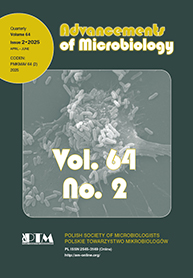LYSSAVIRUS SPP. – RABIES VIRUSES AS A STILL-PRESENT PROBLEM
Abstract: The genus Lyssavirus spp. currently includes 14 species that are responsible for causing rabies, rabies-like and rabies-related diseases. The first symptoms of infection are similar to a cold and mainly include fever, headache and general fatigue. Then comes brain dysfunction and acute neurological symptoms, and ultimately – in most cases – death. Lyssaviruses are spread mainly through direct contact with the carrier that contains the viral reservoir. The gold standard in diagnostics is the method of direct immunofluorescence, through which viral antigens are detected – mainly in the saliva of a patient. Currently, rabies treatment is an experimental form of therapy according to the Milwaukee protocol.
1. Introduction. 2. Systematics. 2.1. Lagos bat virus. 2.2. Mokola virus. 2.3 Duvenhage virus. 2.4. European bat 1 lyssavirus. 2.5. European bat 2 lyssavirus. 2.6. Australian bat lyssavirus. 3. Characteristics. 3.1. Molecular structure. 3.2. Genome and gene expression. 3.3. Life cycle. 4. Pathogenicity. 4.1. Pathogenesis. 4.2. Rabies symptoms. 5. Prevention, prophylaxis, diagnostics, treatment. 5.1. Vaccinations. 5.2. Post-exposure prophylaxis. 5.3. Diagnostics. 5.4. Experimental treatment. 6. Summary
Streszczenie: Rodzaj Lyssavirus spp. obejmuje obecnie 14 gatunków, które odpowiedzialne są za wywoływanie wścieklizny oraz chorób wścieklizno-podobnych i wścieklizno-pokrewnych. Pierwsze objawy infekcji przypominają przeziębienie i obejmują głównie gorączkę, ból głowy i ogólne przemęczenie. Następnie dochodzi do dysfunkcji mózgu i ostrych objawów neurologicznych, a ostatecznie – w większości przypadków – do śmierci. Lyssawirusy rozprzestrzeniają się przede wszystkim przez bezpośredni kontakt ze zwierzęciem stanowiącym rezerwuar wirusowy. Złotym standardem w diagnostyce jest metoda bezpośredniej immunofluorescencji, za pomocą której wykrywane są antygeny wirusowe, głównie w ślinie chorego. Obecnie, do leczenia wścieklizny stosuje się eksperymentalną terapię przeprowadzaną zgodnie z protokołem Milwaukee.
1. Wstęp. 2. Systematyka. 2.1. Lagos bat virus. 2.2. Mokola virus. 2.3 Duvenhage virus. 2.4. European bat lyssavirus typ 1. 2.5. European bat lyssavirus typ. 2. 2.6. Australian bat lyssavirus. 3. Charakterystyka. 3.1. Budowa molekularna. 3.2. Genom i ekspresja genów. 3.3. Cykl replikacyjny. 4. Chorobotwórczość. 4.1. Patogeneza. 4.2. Objawy wścieklizny. 5. Prewencja, profilaktyka, diagnostyka, leczenie. 5.1. Szczepienia. 5.2. Profilaktyka po-ekspozycyjna. 5.3. Diagnostyka. 5.4. Leczenie eksperymentalne. 6. Podsumowanie

